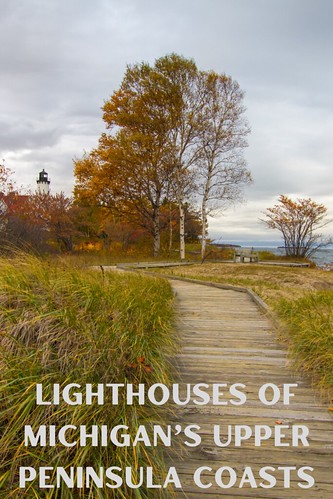Lighthouses of Michigan's Sunset Coasts
From 5/26/22 through 6/8/22, you can get a free 211-page PDF of Exploring Michigan’s Upper Peninsula Coasts, and from 6/9/22 through 6/22/22, you can get a free 386-page PDF of Exploring Michigan’s Sunset Coasts. Go to author Julie Royce’s website at www.jkroyce.wordpress.com. Click the button on the sidebar and provide your email. Your email will be deleted once the book is sent. If you like the book, tell your friends and suggest they get the free PDF or buy the book on Amazon. Better yet, if you like it, write a review on Amazon. Let’s promote Michigan!
Exploring Michigan’s Sunrise Coasts, Exploring Michigan’s Upper Peninsula Coasts, and Exploring Michigan’s Sunset Coasts are available at Amazon.
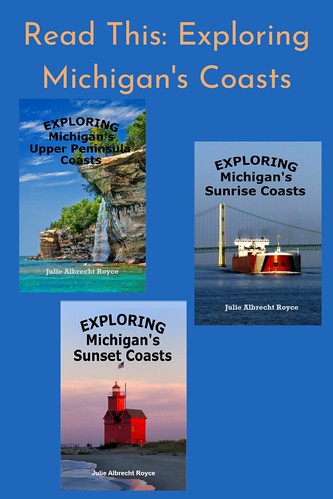
The traveler to Michigan's coastlines will be rewarded with the opportunity to visit many iconic lighthouses. As I traveled, writing and compiling information for my three-volume travel series, Exploring Michigan's Sunset Coasts, Sunrise Coasts, and Upper Peninsula Coasts, they added a bit of delight and historic perspective to the trip. Below are some of my favorites.

Photo courtesy and copyright Lighthouse Photographer Gary Martin, adapted by Wandering Educators
Waugoshance Lighthouse
903 Wilderness Park Dr, Carp Lake
During its working years, this brave lighthouse protected a stretch of the most treacherous waters in Lake Michigan. In the early 1800s, sailors frequently ran aground in the shallow waters of Waugoshance Shoal. Safety required a lighthouse to mark the danger and guide ships into the Straits of Mackinac. In 1832, a lightship was stationed on the shoal to protect water traffic until a lighthouse could be constructed. The lighthouse had to be built on an underwater crib, and that presented a daunting challenge. It had been tried on the East Coast, but would be more demanding in Northern Lake Michigan battered by fierce storms and dangerous winter ice. The project began in 1850, and the lighthouse was completed and put into place in 1851. The 76-foot Waugoshance lighthouse was the first on the Great Lakes to use the Fresnel lens that directed beacons much farther and brighter than lamps alone.
Sixteen years later, weather damage had caused deterioration, and the tower was unstable. The lighthouse needed to be rebuilt. The repairs only lasted 24 years before the structure again needed serious restoration.
For many days in 1871, lighthouse keepers around the state—including James Davenport, who was the assistant keeper at Waugoshance—rang bells warning sailors of shoals as they crept through the smoke from fires that raged throughout Michigan. One story says that Davenport put pots and pans on his lap so that if he fell asleep during his watch, the commotion would awaken him. In spite of valiant efforts, many ships succumbed to the murky gray haze.
Waugoshance was decommissioned in 1912, when the more powerful White Shoals Light a few miles north made the Waugoshance beam redundant.
The lighthouse that had faithfully carried out its duties became a bombing target for pilot training during WWII. A massive fire, likely started by a direct hit, destroyed much of the interior of the tower and the keeper’s dwelling. It is considered one of the most at-risk lighthouses on the lakes. There has been interest and a few attempts to restore the lighthouse. At this time, it is not open to the public. You can get there by boat but must maneuver through dangerous waters. Shepler’s Ferry Service offers annual tours of lighthouses, including one that sails past Waugoshance.
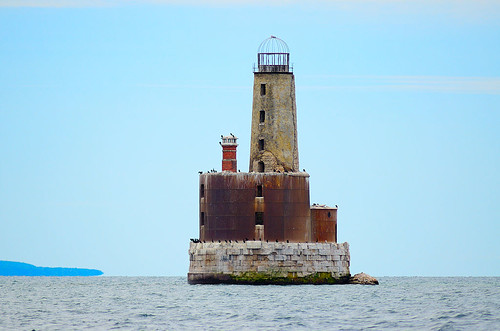
The Ghost of Waugoshance Light
By day, Waugoshance Lighthouse looks like a besieged, worn-down, ancient lighthouse that lacks the strength to harm a soul, as she turns her woebegone countenance to the midday sun. At night, eerily sitting on her crib in dark, roiling Lake Michigan waters, far from shore, she is an ominous presence and home to the ghost of John Herman.
Herman was the keeper of the light from about 1885 to October 14, 1900, when, as the stories go, the waters around Waugoshance ended his life.
Herman was known to imbibe in spirits—the alcoholic kind—maybe a side effect of his confinement on a distant isolated shoal. He was also a practical joker, a personality trait not always appreciated by his assistant, who one moonless and windy night ascended the tower to light the lanterns and heard a lock click behind him. He was the target of yet another of Herman’s jokes. The irritated assistant began rattling the door and yelling, “John, John, stop this nonsense. Let me down.”
After he believed the joke had run its course, but before his pal would be angry enough to do him bodily harm, Keeper John Herman drunkenly staggered along the pier intending to unlock the door. Instead, he slipped, lost his footing, and plunged, screaming and flailing, into the churning waves, where he drowned.
After several hours of patiently waiting for John to release him, the assistant signaled a nearby lighthouse, and another keeper arrived to investigate the problem. The two men searched for Herman, but his body was never recovered. For the next twelve years, lighthouse keepers contended with Herman’s ghost, who continued his pranks. During checkers games, Herman tipped keepers over in their chairs, even when they had not been leaning backward. Doors were locked, but not by the hand of a living soul. The lighthouse’s reputation and the stories of its many strange occurrences spread, and the haunting kept many keepers from accepting the assignment. Even though Waugoshance is now decommissioned, Keeper John Herman walks the crib and continues to inhabit the lighthouse that claimed his life more than 120 years ago.
Point Betsie Lighthouse
3791 Point Betsie Road, Frankfort
Built in 1858, Betsie was not fully automated until 1983. The name, Betsie, did not come from a desire to honor someone’s wife or mother. Instead, it came from the French name Pointe Aux Becs Scies, meaning Saw Beak Point. The English-speaking settlers in the area shortened and ran the words together, so Becs Scies became Betsie.
Betsie was the last manned lighthouse on Lake Michigan, and she marked the end of an era. After automation, Betsie became a coast guard residence until 1996 ,when her boiler failed, and the families living there were forced to abandon her.
The two-story white keeper’s house sits on a slight knoll and offers an expansive view of the area. The red-shingled hip roof with dormers adds an element of drama to the 3,000 square foot dwelling that accommodated two families. Covered porches provide a homey touch. A three-story tower, tall enough to let someone look out from the parapet and see over the house, is attached to Betsie’s side. At 37 feet, she is one of the shorter lighthouses on the lake. Steel breakwaters were constructed from the base of the tower toward the lake in an attempt to minimize damage from the power of angry waves.
Surrounded by shifting dunes, the tranquility of the location makes it one of the more scenic and peaceful lights on the lake. Betsie remains active today.

Grand Haven South Pierhead Inner Light and the Grand Haven South Pierhead Entrance Light
1001 South Harbor Drive, Grand Haven
The two lights share a common history. Established in 1839 on the south pier where the Grand River enters Lake Michigan, both are painted red and connected by a lighted catwalk that makes them accessible to each other, to the shore, and to the Grand Haven Boardwalk.
The inner light is cylindrical, and the fog house outer light stands on a huge concrete foundation. These are among the most photographed lighthouses on the Great Lakes. The pier boardwalk is the place for strolls, perfect sunsets, and photo opportunities.
The lighthouses were offered for sale in 2009 under the National Historic Lighthouse Preservation Act. The City of Grand Haven now owns the pier and lights, but they are maintained by the Army Corps of Engineers.

Holland Harbor Lighthouse (Big Red)
2215 Ottawa Beach Road, Holland
The lighthouse provides one of Michigan’s most popular photo-op sites. Visitors find great views from the North Pier boardwalk, Holland State Park, and Mount Pisgah. Big Red is at the entrance to the channel connecting Lake Michigan with Lake Macatawa. It is on the south side of the channel. Two modern lights mark the ends of the breakwaters that extend into Lake Michigan.
The United States Lighthouse Board was slow to respond to Holland’s request for a channel from Lake Macatawa to Lake Michigan and a lighthouse for the safety of ships docking there. The frustrated citizens dug the channel themselves, and after decades of unanswered requests, the lighthouse board finally recommended construction of the first light at Holland Harbor, and the application was approved by the U.S. Congress. In 1886 the harbor’s first lifesaving station was established. The lighthouse was automated in 1932.
In 1970, the Coast Guard recommended abandonment of Big Red, but local citizens came to the rescue, creating Holland’s Harbor Lighthouse Historical Commission to preserve and restore the beloved landmark.
Public access to Big Red is limited, because you must cross private property to reach it. A photo of Big Red graces the cover of Exploring Michigan’s Sunset Coasts, courtesy of Lighthouse Photographer Gary Martin. Regarding this photo, Martin says, “That's my all-time favorite. There is one week in the spring and one in the fall when the sun rises and shines directly down the channel leading in to Lake Makatawa and reflects off the side of Big Red onto the sand. You have to have wet sand and just enough wave action to keep the sand wet to capture the reflected light as reflected in this photo. It took five years of going up to Big Red for the conditions to finally come together to capture the image that you see. There were a bunch of close but no cigar tries. and it was great when persistence finally paid off!”

Big Red, courtesy and copyright Lighthouse Photographer Gary Martin
South Haven South Pierhead Light
Water St, South Haven
The South Haven South Pierhead Light stands at the entrance to the Black River on Lake Michigan. Made of cast iron and 35 feet tall, it has offered guidance to ships since 1903, when it replaced the original 1872 tower. The light is still operational. The catwalk is an elevated walkway, constructed so that during high waves, the lighthouse keeper could have safer access by entering the tower through a second-level entrance door. Only three other lighthouses besides South Haven still have an elevated walkway: St. Joseph, Grand Haven, and Manistee. In the 1920s, daredevils dove off the top of the lighthouse.
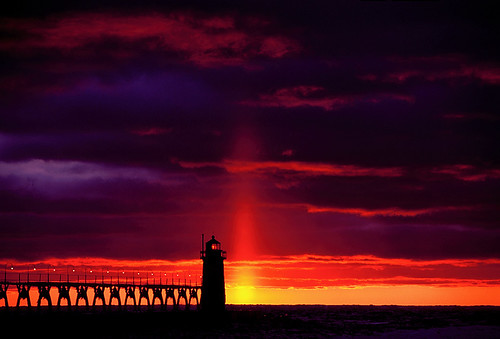
South Haven South Pierhead Light, courtesy and copyright Lighthouse Photographer Gary Martin. Martin notes, “The column of light going into the heavens is the sun pillar... It's caused by flat, hexagonal plate-like ice crystals reflecting light back to the viewer after the sun drops below the horizon... I've only seen a few of them over the years but they are always spectacular.”
The 2½ story keeper’s house was a wood, hip-roofed home located onshore at 91 Michigan Avenue. The dwelling was transferred to the city for preservation in 2000, and the Michigan Maritime Museum has renovated it as the Marialyce Canonie Great Lakes Research Library.

South Haven South Pierhead Light, courtesy and copyright Lighthouse Photographer Gary Martin
Responsibility for the South Haven Lighthouse was transferred from the Coast Guard to the Historical Association of South Haven in 2012. The Historical Association raised the money for a complete restoration.
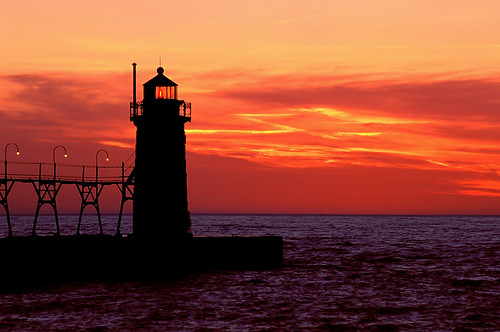
South Haven South Pierhead Light, courtesy and copyright Lighthouse Photographer Gary Martin
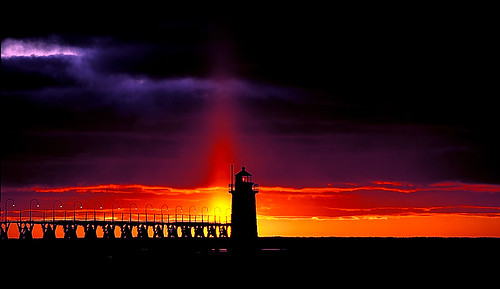
South Haven South Pierhead Light, courtesy and copyright Lighthouse Photographer Gary Martin
St. Joseph North Pier Outer Lighthouses and St. Joseph North Pier Inner Lighthouse
North Pier Street, St. Joseph
The Outer Lighthouse perches on the north breakwater at the mouth of the St. Joseph River. The structure is a round, cast-iron plated 35-foot-tall tower topped by a round watch room and a 10-sided lantern room. Toward the middle of the pier sits the St. Joseph North Pier Inner Light. The two lights are connected by an elevated catwalk that extends from the shore to the outer light.

St. Joseph Pier, sun slipping toward the horizon. Photo courtesy and copyright Lighthouse Photographer Gary Martin
The original St. Joseph lighthouse was lit in 1832, just months after the first lighthouse on Lake Michigan commenced operation at Chicago. In 1859, a new two-story lighthouse with a frame keeper’s dwelling and a square tower rising from one end of its peaked roof took over safeguarding the waters around St. Joseph. This second light was roughly 48 feet tall, but because it sat on a bluff, it gave a focal plane of 101 feet above lake level. In 1864, the color of the light was changed from white to red to distinguish it from other lights along the coast.

St Joe Lights at Sunset. Photo courtesy and copyright Lighthouse Photographer Gary Martin
The mainland light was discontinued in 1885, and the position of keeper was eliminated until 1889, when the mainland light was reactivated. In 1904, the War Department extended the north pier. Today’s range lights on the north pier were constructed in 1907. The steel framing of the front tower tapers slightly from its base to its nine-sided lantern room.

The aurora to silhouette the St Joe pier. Photo courtesy and copyright Lighthouse Photographer Gary Martin
The rear tower is a 24-foot-square steel structure with a pyramidal roof surmounted by an octagonal tower. The pier’s original steam whistle was transferred to the lower portion of the new structure. A diaphone fog signal was installed in the rear tower in 1933.
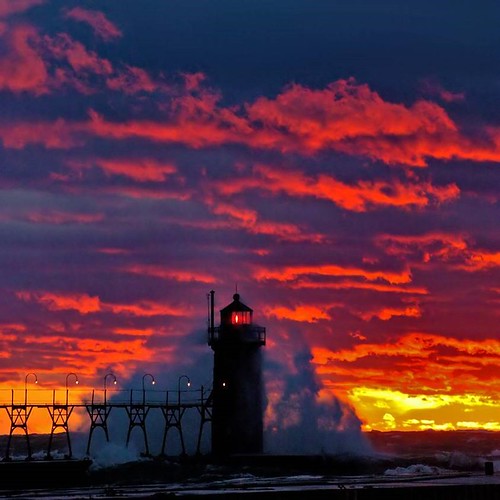
St. Joseph Pier Light during a winter storm. Photo courtesy and copyright Lighthouse Photographer Gary Martin
The original 1859 lighthouse was razed to build a parking lot. In May 2008, the St. Joseph Pierhead and Inner Lights were deemed excess by the Coast Guard. They were offered at no cost to eligible entities. After some negotiating about what would be done with them and how they would be preserved, the pier lights went to the City of St. Joseph. The lights needed a great deal of restoration, and fundraising began to raise money for the project.
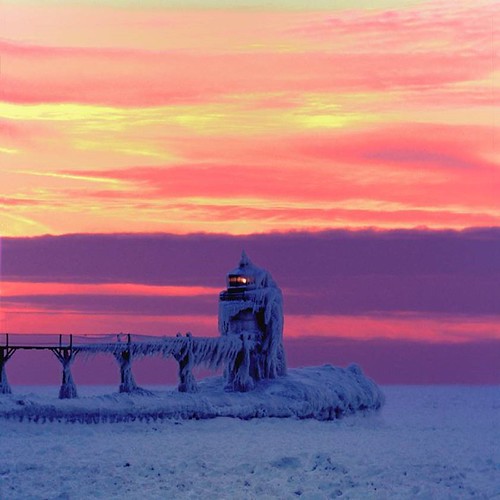
To get the angle of the sunset in winter Gary was about 1/4 of a mile out onto the frozen lake. He says "it felt like he was on an alien world...no sounds but the wind and the creak and groan of the ice beneath my feet." Photo courtesy and copyright Lighthouse Photographer Gary Martin
Today, St. Joseph, South Haven, and Grand Haven are the only piers on the Great Lakes that retain their range lights and catwalks. A commemorative stamp with the St. Joseph Pier Lights was issued in 1995.
Thank you to Lighthouse Photographer, Gary Martin (www.coastalbeacons.com) for the many photos of some of the lighthouses along Michigan's Sunset Coasts.
Click the photos to read more Michigan Lighthouse goodness!
and
Click through to read excerpts from Royce's three books exploring Michigan's coasts:
Julie Albrecht Royce, the Michigan Editor for Wandering Educators recently published a three-book travel series exploring Michigan’s coastlines. Nearly two decades ago, she published two traditional travel books, but found they were quickly outdated. This most recent project focuses on providing travelers with interesting background for the places they plan to visit. Royce has published two novels: Ardent Spirit, historical fiction inspired by the true story of Odawa-French Fur Trader, Magdelaine La Framboise, and PILZ, a legal thriller which drew on her experiences as a First Assistant Attorney General for the State of Michigan. She has written magazine and newspaper articles, and had several short stories included in anthologies.


